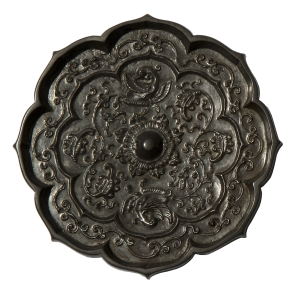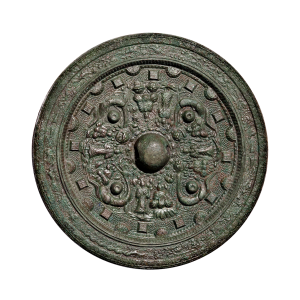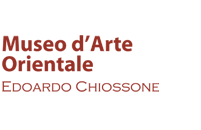In China, from the second millennium BC, mirrors were cast in bronze and less frequently in copper, gold and silver. The reflective side was obtained by smoothing the metal to the maximum brilliance and silvering it, while the reverse of the mirror housed ornamental motifs and inscriptions of symbolic and religious significance.
At the centre of the reverse a perforated knob allowed the insertion of a cord to grip and handle the mirror. The generally round shape expressed the idea of unity, harmony and completeness: therefore mirrors, exchanged as gifts between friends, meant sincerity and respect. While the square shape was rare at all times, the octagonal and eight-foiled ones was frequent in the Tang (618-907) and Song (960-1279) periods.
The belief that mirrors had the magical power to exorcise evil spirits was deeply rooted: this explains why in East Asia mirrors were very important elements of burial goods. In addition, mirror-talismans were widespread among the Taoist clergy, decorated with the Eight Trigrams of the Book of Changes and other talismanic images, such as the diagram of the Seven Celestial Illuminations, the spirit animals, the Immortals and the Celestial Couple.
A very important piece of the Chiossone collection, presents a rare combination of Taoist and Buddhist symbols: the Semicircle and square mirror with four animals, ten Buddhist divinities and four small nubs (display case 2), was donated to Edoardo Chiossone in 1881 by Saisho Atsushi, Prefect of Osaka, as a symbol of respect and friendship, and can be dated to between the fifth and sixth centuries. An identical specimen, excavated at the Kongōrin-ji temple in akasaka, is kept in the National Museum of Kyōto and appears on the Japanese national list of Important Cultural Heritage (jūyō bunkazai).
In Japan the mirror (kagami) is an attribute of the sun goddess of Amaterasu, the mythical founder of the imperial dynasty and central divinity of the Shintō religion, the indigenous animist cult of the archipelago: in many Shintō temples, in fact, a sacred mirror is kept, considered goshintai (verum corpus) of the divinity. Since late Japanese prehistory the mirror, together with the sword and the "curved jewel" (magatama, display case 1), has been the bearer of a great mythical, religious and political symbolism.
The oldest Chinese mirrors found in Japan in the burials of leading figures of the Yayoi Period (ca. 300 BC-300 AD) date to the Han Period (206 BC-220 AD). In the following Kofun period (ca. 300-710) the mirrors of the princely funeral items increased in number and, interestingly, showed the coexistence of ancient and contemporary Chinese pieces along with Japanese copies.
The Chinese influence remained in Japan throughout the VII-XIV centuries, although Japanese production gradually showed technical, figurative and ornamental characteristics more defined and ever more related to local customs. In Japan mirrors with handles (e-kagami) were produced for the first time in the Muromachi period (1393-1572): the central knob, still present in the first specimens, disappeared in the following Momoyama (1573-1603) and Edo (1603 -1868) periods.
Eight-lobed mirror with a pair of phoenixes and flowers

Eight-lobed mirror with a pair of phoenixes and flowers

Eight-lobed mirror with a pair of phoenixes and flowers

Eight-lobed mirror with a pair of phoenixes and flowers

Mirror with four bosses, four animals and ten Buddhist deities, gift of Atsushi Saisho to Edoardo Chiossone,

Mirror with four bosses, four animals and ten Buddhist deities, gift of Atsushi Saisho to Edoardo Chiossone,

Mirror with four bosses, four animals and ten Buddhist deities, gift of Atsushi Saisho to Edoardo Chiossone,

Mirror with four bosses, four animals and ten Buddhist deities, gift of Atsushi Saisho to Edoardo Chiossone,





